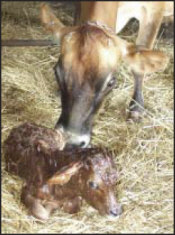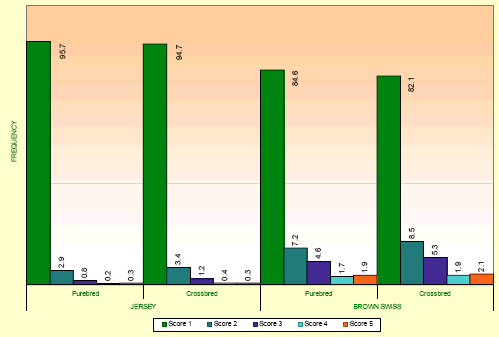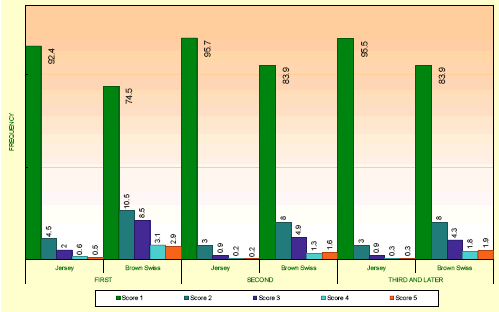



Genetic Calving Ease Study on Crossbreds
J. B. Cole, R. C. Goodling, Jr., G. R. Wiggans and P. M. VanRaden Animal Improvement Programs Laboratory, Agriculture Research Service, USDA. The objective of this study was to examine the feasibility of implementing routine national calving ease genetic evaluations of Brown Swiss and Jersey sires that include records of crossbred calvings.li{background-position:0px 2px;padding-left:25px;;list-style-image:url(Y:/News/TheCattleSite/Images/News-CowBulletPoint.jpg);}
Records were available for 11,793 Brown Swiss calvings, 3,431 Brown Swiss-sired crosses, 65,293 Jersey calvings and 7,090 Jersey-sired crosses. Results show that Jersey cows had very little calving difficulty and Jersey bulls had a very small range of evaluations. This suggests that a routine Jersey evaluation would be of little value to Jersey producers because differences amont sires are very small.
Introduction
 |
| The study done by Cole et al. proves what Jersey breeders have known all along: Jerseys, including crossbreds, are easycalvers. |
In a recent survey of U.S. dairy producers that use crossbreeding, almost all respondents indicated a desire to improve calving ease, as well as health, fertility and longevity (Weigel and Barlass, 2003).
Jersey-Holstein crossbred heifers and cows had significantly lower phenotypic dystocia scores than their purebred Holstein contemporaries, 1.32 versus 1.94, in a study done by Heins et al. (2003b). A related study by the authors (2003a) reported that Jersey-sired calves were born with significantly lower dystocia scores than Brown Swiss-sired calves and Brown Swiss-sired calves had significantly lower dystocia scores than Holstein-sired calves in a population of Holstein, Holstein- Jersey and Holstein-Normande cows. McClintock et al. (2004) presented further evidence that Jersey-Holstein crossbreds have a lower incidence of dystocia than purebred Holsteins.
No difference for dystocia was found between Holstein-Jersey and Jersey- Holstein calvings (Cassell et al., 2004), although the sample size was very small. Heins et al. (2004) reported that Holstein-sired calvings had significantly more dystocia than Jersey-sired calvings. These results suggest that use of sires from several non-Holstein breeds in a crossbreeding program may result in reduced incidence of dystocia.
In response to this interest, the Animal Improvement Programs Laboratory (AIPL) studied calving ease in the Brown Swiss and Jersey breeds.
The objectives of this research were:
- to determine the extent to which calving ease data are recorded in the Brown Swiss and Jersey breeds;
- to characterize the available calving ease data for the two breeds, as well as for Brown Swiss and Jersey-sired crosses;
- to perform preliminary prediction of PTA for these breeds, as well as for Brown Swiss and Jersey-sired crosses using the available data; and
- to develop a procedure for routine national evaluations for the two breeds, if appropriate.
Materials and Methods
Calving ease records for Brown Swiss and Jersey-sired purebred and crossbred calvings were extracted from the AIPL database. Four datasets were created to estimate breeding value: Brown Swiss-sired purebred calvings; all calvings in Brown Swiss, plus Brown Swiss-sired crossbred calvings; Jersey-sired purebred calvings (JEp); and all calvings in Jersey, plus Jersey-sired crossbred calvings (JEc).
Results
Sufficient numbers of Brown Swiss and Jersey records were available to provide exploratory evaluations for calving ease in the two breeds. Too few Ayrshire, Guernsey and Milking Shorthorn calvings were available to provide accurate evaluations for those breeds. Distributions of calving ease scores by data set are shown in Table 1.
Purebred = purebred only; Crossbred = purebred and crossbred calvings. Calving ease scores: 1 = no problem; 2 = slight problem; 3 = needed assistance; 4 = considerable force; 5 = extreme difficulty. Calving ease scores of 4 and 5 were combined into a single score of 4 for each Jersey evaluation.
The purebred and crossbred datasets had similar distributions of scores within sire breeds and very different distributions between sire breeds. Similar trends were seen in score distributions by parity, shown in Table 2. For first parity in the JEc dataset, the incidence of calving difficulty (scores of 4 or 5) was 1.1%, the highest value for any parity in either dataset. Scores of 1, which indicated no problems, were recorded for more than 92% of all calvings. This is consistent with evidence that Jerseys are easy calvers (Thompson et al., 1981).
Distributions of service sire and daughter percent difficult births (%DBH) in heifers indicated %DBH of 2 and 1 are most common for service sire calving ease (SCE) and daughter calving ease (DCE), respectively, in the Jersey purebred dataset. Only two Jersey bulls had a PTA greater than 2 for SCE, and only one had a PTA greater than 2 for DCE. No Jersey bull had a PTA greater than 3 for any trait in either data set.
Clearly, relative to other breeds, there are very small genetic differences among Jersey sires and maternal grand sires for SCE and DCE. There are adequate calving ease data available in both breeds for genetic evaluation. Although there is sufficient genetic variability in the Brown Swiss to make a routine genetic evaluation worthwhile, that is not the case with the Jersey.

Conclusions
Jerseys had very little calving difficulty and thus a very small range of evaluations. This is consistent with anecdotal evidence which suggests that Jerseys rarely experience calving difficulty. There may be some genetic variation on the underlying scale that translates to too little observed variation because the Jersey base is so small. The implementation of a routine national genetic evaluation for calving ease would not provide Jersey breeders with a useful tool for genetic improvements.December 2006


